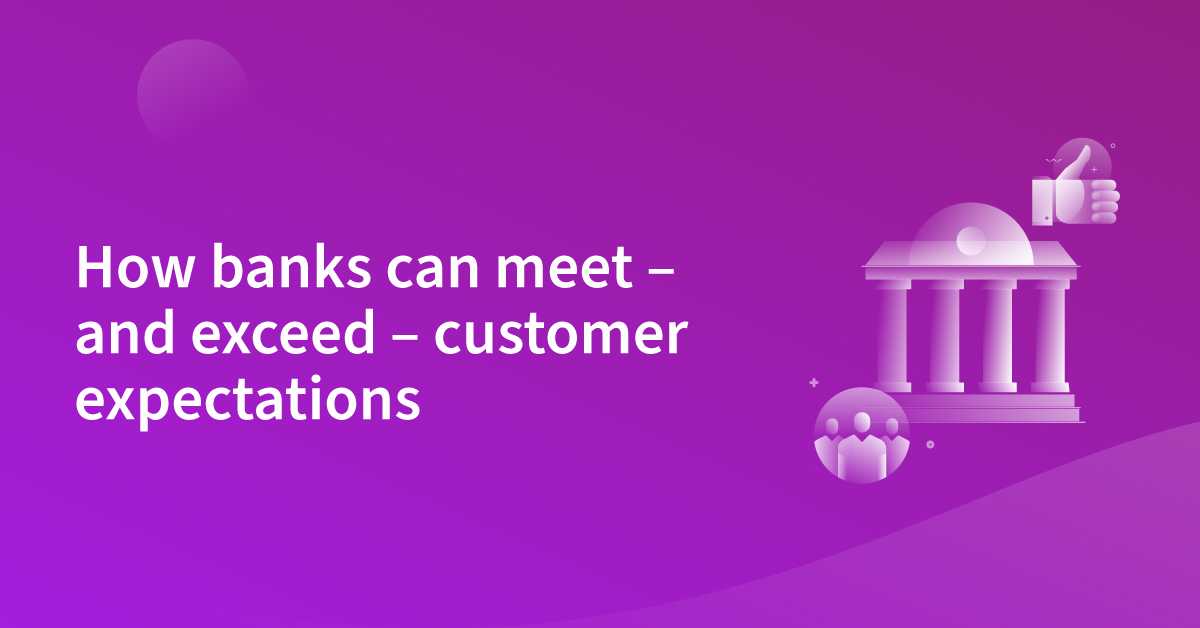How banks can meet – and exceed – customer expectations

How banks can meet – and exceed – customer expectations
Banking is changing. Customers are re-evaluating their relationship with money thanks to evolving expectations and the rise of digital banking changing habits, which has been accelerated by the pandemic.
Great expectations
Expectations is the keyword. In an environment where change is accelerating and Big Tech is making inroads in financial services, incumbents need to reimagine customer experience to stay relevant and competitive.
This doesn’t mean tweaks or gimmicks. It means wholesale change in how customers engage with brands, products and people. On a practical level, this means rewiring the customer-facing functions of the organisation – marketing, commerce, sales and service. Those touchpoints are integral mechanisms for how people interact with their money. This primary relationship with money is and will become a fundamental facet of banking in a digitally native world. That is not to discount physical interactions such as from branches as this is an area that incumbents are differentiated from many of the new FinTechs but quite simply, the old ways of doing things just won’t cut it in the new world.
We’ve written extensively about the importance of purpose. Not only can purpose rehabilitate the image of banks still suffering from the fallout from the Global Financial Crisis – it can ignite sustainable growth, leading to better outcomes for stakeholders, customers and society.
What we have currently is a potential golden era of disruption in the industry. But the interesting thing is that this can come from within. How can banks reinvent themselves?
So what other elements should banks focus on when it comes to exceeding customer expectations?
A case in point: The neglected middle
When it comes to product variety and accessibility it is safe to say that current processes such as obtaining credit for homes, autos and businesses can feel outdated and confusing. And a significant portion of the population is being denied credit by traditional lenders – despite the fact they are creditworthy.
In the US, for instance, 45 million people are considered “credit invisible”. Globally, meanwhile, roughly 1.7 billion adults with a net worth of $10,000 to $100,000 – dubbed “the neglected middle”– lack products and services that adequately meet their needs.
This group includes women, immigrants, and foreign workers who often lack the local financial track record needed to obtain credit. And then there’s Centennials – those born after 1997 who have not yet developed a robust credit history. This situation needs to change. Thankfully, it is.
One lender’s loss is another’s again. The “neglected middle” is attracting the attention of disruptive challengers with the technological infrastructure to make sophisticated lending decisions based on alternative data sources, new risk analysis techniques, and greater automation. For example, Braviant Holdings looks beyond credit scores, using automation, machine learning and alternative data sources to build models that predict willingness and ability to pay, providing customers a path to better credit scores.
In the short-term credit sector we are seeing a bottom upshift of power away from banks towards consumers, who are now able to find financing from progressive financial institutions like Capital One or fintech platforms like Kabbage, Klarna, and Affirm. UK-based Oaknorth is leading the charge here, leveraging alternative data to keep non-performing loans at an incredibly low rate: just two defaults in four years of lending €3 billion ($3.6 billion) to individuals and SMBs.
We’ve explored the power of Gen Z before on the blog. And this only exposes a wider issue within the industry in terms of moving with the times and leveraging technology like data and AI to expand narrow fields of the idea of the customer and provide modern, simplified services that meet customers needs and expectations.
The game has changed
Banks are no longer just competing with each other. For instnace the “buy now, pay later” brands have redefined standards for short-term credit. Unlike banks, who tend to be encumbered with legacy data and risk models, they have been able to build superlative customer experiences from first principles.
There is much more than credit provisioning that banks must get right to retain relevance and grow in this fast-moving and future-forward landscape but pick at almost any financial services product these days and you will catch a glimpse at a market ripe for disruption.
Therefore in order to build products that align with what people need and expect and, in fact, build new ones that meet unmet needs and the ‘I didn’t know I needed this until I saw it’ market banks must reimagine their products, models and culture. This makes sense. Serving previously overlooked segments is good for both business and society. And lessons learned from serving segments such as the neglected middle will provide new approaches for traditional audiences as we move towards the next-generation banking experience.